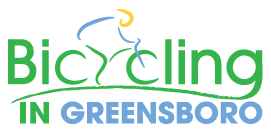|
Reasons for Opposition: NCDOT's Proposal for Benjamin Parkway
- Having to cross Pembroke and Cornwallis as a pedestrian in a "z" pattern would have kept many cyclists from crossing these intersections. Since there isn't another alternative crossing nearby, this would have meant less people choosing to commute by bike.
- Cyclists are legally allowed to ride on this portion of Benjamin Pkwy, yet if they stayed on their bike and attempted to cross Benjamin off of Cornwallis or Pembroke, they would have had to make a right turn and merge over many lanes alongside car traffic.
- Drivers would have most likely travelled at higher speeds since level of service was prioritized in the design, further increasing the risk of cyclists suffering serious injury or death.
- Greensboro and NCDOT have worked hard to plan and start implementing bicycling and pedestrian networks to encourage people to use alternative transportation. This project would have divided several major bicycling routes, eliminating nearby access to the Bicentennial Park, Bog Garden, Friendly Center, etc.
- This is a residential area. Adding lanes would have further divided the neighborhood that runs along both sides of this portion of Benjamin. Historically this has been done to communities across the nation, particularly in the 1950's and 1960's. There is abundant evidence that adding additional lanes to highways that run through residential neighborhoods further destroys the sense of community.
- The sidewalk that had been proposed as an alternative to the current shoulder did not make sense. Who would have used it? It would not take people anywhere.
- The draft proposal ran counter to so many of Greensboro's current plans and initiatives:
- GSO2040 aims for GSO to be car optional by 2040.
- Vision Zero Greensboro and NC Vision Zero: creating complete streets for all people to use, regardless of whether they choose to bike, walk, ride the bus, or drive.
- Greensboro's Safe Routes to School and the NCDOT Safe Routes to School grant, program: " a national initiative which supports the planning, development, and implementation of projects and activities to encourage children of all abilities to walk or bike to school."
- Greensboro’s Bicycle, Pedestrian, Trails and Greenways Plan: The intent is to create multi-modal infrastructure that makes sense when looking at the bigger picture. Bicycling and pedestrian infrastructure will only succeed if people can use them as intended: - as a way to get places. The goal has to be to create transportation networks so that all modes of transportation have the infrastructure needed to travel as safely as possible regardless of the destination.
- Greensboro Parks and Recreation’s Plan2Play: envisions a network of greenways that connect parks and, in turn, neighborhoods.
- The decision to do this project is based on 2040 projections. However, there is evidence that this design will induce demand: Adding lanes encourages more people to use the road or highway, which is counterintuitive. Furthermore, creating projects that keep cyclists off public streets and people opting to drive instead of walk will inevitably mean more car traffic.
- More people using Benjamin would have meant more congestion on connector roads such as Green Valley, Friendly Ave., Hobbs, etc.
- GDOT had not been happy with this project for many reasons. One was that they are planning to work on an exit off Wendover which is near this stretch of Benjamin. They had raised the concern that the two projects should be planned in conjunction with one another in order to optimize outcomes. Of course, local advocates will not be able to voice their opinion about GDOT intentions until more information has been provided. Regardless, it would have made sense to heed their concerns instead of wasting time and money on a project that would not work well with plans that are in the works.
- Communication is a key component of successful planning. All of the stakeholders involved should have been in the loop and on the same page. Most transportation projects, including this proposal, will have an effect to one degree or another on the initiatives, plans, policies, and projects that other local transportation-related government entities have in the works.
